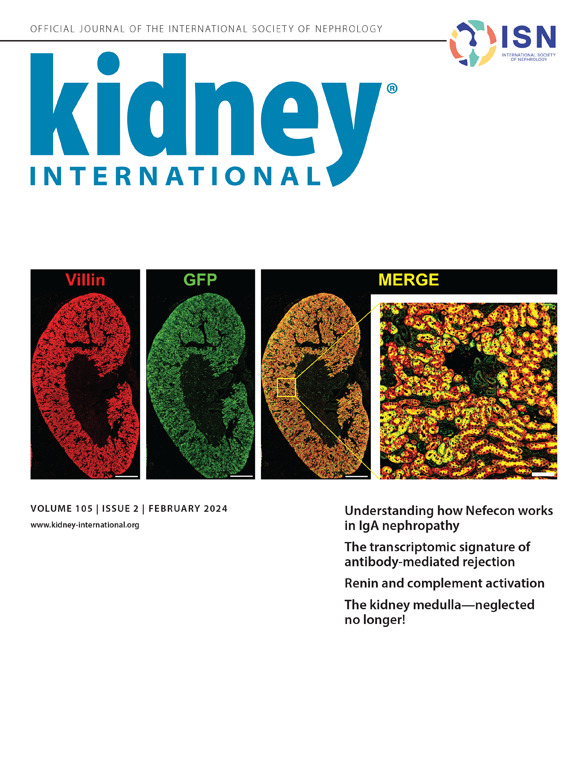在一项前瞻性多中心非选择性队列研究(EU-TRAIN)中评估肾移植排斥反应的非侵入性生物标志物。
IF 14.8
1区 医学
Q1 UROLOGY & NEPHROLOGY
引用次数: 0
摘要
非侵入性生物标志物是改善肾脏异体移植排斥反应监测的有前途的工具,但其临床应用需要在专门设计的研究中获得更多证据。为了满足这一尚未满足的需求,我们设计了 EU-TRAIN 研究,这是一项由欧盟委员会资助的大型前瞻性多中心非选择性队列研究。在此,我们纳入了 2018 年 11 月至 2020 年 6 月期间在九个欧洲移植中心接受肾脏异体移植的连续成年患者。我们前瞻性地评估了 19 种血液信使 RNA 的基因表达水平、四种针对非人类白细胞抗原(HLA)内皮抗原的抗体以及循环中的抗 HLA 供体特异性抗体(DSA)。主要结果是移植后第一年的异体移植排斥反应(抗体介导、T细胞介导或混合)。共纳入了 412 名患者,其中 812 例活检与血液样本配对。CD4基因表达与排斥反应明显相关,而循环抗HLA DSA与异体移植排斥反应明显相关,与抗体介导的排斥反应密切相关。所有其他检测的生物标记物,包括 AKR1C3、CD3E、CD40、CD8A、CD9、CTLA4、ENTPD1、FOXP3、GZMB、ID3、IL7R、MS4A1、MZB1、POU2AF1、POU2F1、TCL1A、TLR4 和 TRIB1、血管紧张素II 1型受体抗体、内皮素1 A型受体抗体、C3a和C5a受体抗体与同种异体移植排斥反应无明显关联。血液信使 RNA 和非 HLA 抗体在预测移植后第一年的异体移植排斥反应方面没有显示出超出标准护理监测参数和循环抗 HLA DSA 的额外价值。因此,我们的研究结果为专门设计研究以证明其他候选非侵入性生物标志物的临床相关性和在肾移植实践中的应用开辟了道路。本文章由计算机程序翻译,如有差异,请以英文原文为准。

Evaluation of non-invasive biomarkers of kidney allograft rejection in a prospective multicenter unselected cohort study (EU-TRAIN)
Non-invasive biomarkers are promising tools for improving kidney allograft rejection monitoring, but their clinical adoption requires more evidence in specifically designed studies. To address this unmet need, we designed the EU-TRAIN study, a large prospective multicentric unselected cohort funded by the European Commission. Here, we included consecutive adult patients who received a kidney allograft in nine European transplant centers between November 2018 and June 2020. We prospectively assessed gene expression levels of 19 blood messenger RNAs, four antibodies targeting non–human leukocyte antigen (HLA) endothelial antigens, together with circulating anti-HLA donor-specific antibodies (DSA). The primary outcome was allograft rejection (antibody-mediated, T cell–mediated, or mixed) in the first year post-transplantation. Overall, 412 patients were included, with 812 biopsies paired with a blood sample. CD4 gene expression was significantly associated with rejection, while circulating anti-HLA DSA had a significant association with allograft rejection and a strong association with antibody-mediated rejection. All other tested biomarkers, including AKR1C3, CD3E, CD40, CD8A, CD9, CTLA4, ENTPD1, FOXP3, GZMB, ID3, IL7R, MS4A1, MZB1, POU2AF1, POU2F1, TCL1A, TLR4, and TRIB1, as well as antibodies against angiotensin II type 1 receptor, endothelin 1 type A receptor, C3a and C5a receptors, did not show significant associations with allograft rejection. The blood messenger RNAs and non-HLA antibodies did not show an additional value beyond standard of care monitoring parameters and circulating anti-HLA DSA to predict allograft rejection in the first year post-transplantation. Thus, our results open avenues for specifically designed studies to demonstrate the clinical relevance and implementation of other candidate non-invasive biomarkers in kidney transplantation practice.
求助全文
通过发布文献求助,成功后即可免费获取论文全文。
去求助
来源期刊

Kidney international
医学-泌尿学与肾脏学
CiteScore
23.30
自引率
3.10%
发文量
490
审稿时长
3-6 weeks
期刊介绍:
Kidney International (KI), the official journal of the International Society of Nephrology, is led by Dr. Pierre Ronco (Paris, France) and stands as one of nephrology's most cited and esteemed publications worldwide.
KI provides exceptional benefits for both readers and authors, featuring highly cited original articles, focused reviews, cutting-edge imaging techniques, and lively discussions on controversial topics.
The journal is dedicated to kidney research, serving researchers, clinical investigators, and practicing nephrologists.
 求助内容:
求助内容: 应助结果提醒方式:
应助结果提醒方式:


